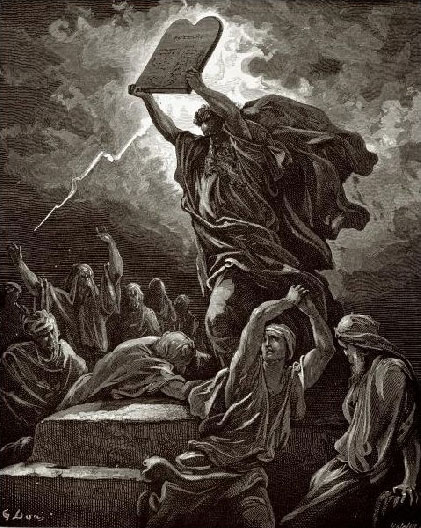Jun
19
2009
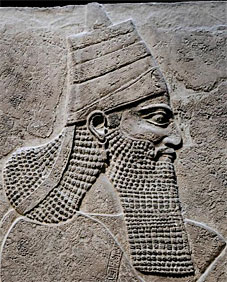 “Assyria dominated the ancient world in the centuries before the exile of Judah. Sometime during the reign of Jeroboam II of Israel (832–792 bc), and probably toward the latter part of that reign, the Israelite prophet Jonah had been used by God to convert the city Nineveh and all its citizens to the worship of the true God. Jonah 3:5 and 4:11 indicate that God showed His mercy to the children of the city, so that we are entitled to assume that there were God-fearing people alive for the next seventy or so years in Assyria…
“Assyria dominated the ancient world in the centuries before the exile of Judah. Sometime during the reign of Jeroboam II of Israel (832–792 bc), and probably toward the latter part of that reign, the Israelite prophet Jonah had been used by God to convert the city Nineveh and all its citizens to the worship of the true God. Jonah 3:5 and 4:11 indicate that God showed His mercy to the children of the city, so that we are entitled to assume that there were God-fearing people alive for the next seventy or so years in Assyria…
Continue reading
Comments Off | tags: Assyria, Bible history, James Jordan, Jeremiah, Nineveh, Remnant | posted in Quotes
Apr
15
2009
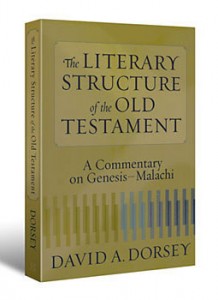 “I began writing this book some ten years ago, although my interest in Hebrew literary structure goes back a decade before that. My fascination with the subject was kindled when I began teaching Old Testament courses in seminary. At that time I was struck by the apparent lack of order within many of the biblical books. Jeremiah seemed hopelessly confused in its organisation; so did Isaiah and Hosea and most of the prophets. Song of Songs and Ecclesiastes appeared to be in almost complete disarray, and even the more orderly historical books, such as Joshua and Kings, showed signs of strangely careless organisation. Why did the biblical authors write like this? I would never write a book, an article, or even a private letter with such carelessness of arrangement.
“I began writing this book some ten years ago, although my interest in Hebrew literary structure goes back a decade before that. My fascination with the subject was kindled when I began teaching Old Testament courses in seminary. At that time I was struck by the apparent lack of order within many of the biblical books. Jeremiah seemed hopelessly confused in its organisation; so did Isaiah and Hosea and most of the prophets. Song of Songs and Ecclesiastes appeared to be in almost complete disarray, and even the more orderly historical books, such as Joshua and Kings, showed signs of strangely careless organisation. Why did the biblical authors write like this? I would never write a book, an article, or even a private letter with such carelessness of arrangement.
I was intrigued by the possibility that the Hebrew authors might have organised their compositions according to literary conventions that were different from ours. I began to discover, over a period of years, that several structuring patterns rarely used by us were remarkably common in the books of the Hebrew Bible, particularly chiasmus (symmetry), parallelism, and sevenfold patterns. I was increasingly struck by how often these patterns had been utilised to arrange biblical books…
It was my mother who gave me a love for literature. She read to my brother Stephen and me regularly, from as early as I can remember. I still have many fond memories of those wondrous bedtime stories, whose structures — like the Bible — were designed for the ear, not the eye.”
David A. Dorsey, The Literary Structure of the Old Testament, p.9-10 (Preface).
Comments Off | tags: Chiasm, David A. Dorsey, Ecclesiastes, Hebrew, Isaiah, Jeremiah, Literary Structure, Old Testament, Song of Songs | posted in Quotes
Apr
10
2009
I received horrified reactions for using this phrase. God hates divorce, and yet…
“Then I saw that for all the causes for which backsliding Israel had committed adultery, I had put her away and given her a certificate of divorce; yet her treacherous sister Judah did not fear, but went and played the harlot also.”(Jeremiah 3:8)
Q: How could God divorce and remarry, and yet keep the Law? Marriage is “till death.”
A: Through death and resurrection.
The only way the Lord could make a new covenant was through death and resurrection. Not only did Israel die, but the Covenant died – the Ark was taken by God. Jeremiah predicted the Restoration Covenant, and redeemed some Land to prefigure what God Himself would do after the captivity.
The entire pattern was repeated in the first century. Christ, the Ark, ascended to God as firstfruits, and Israel also died, and was resurrected as the Christian church. There were two feasts in AD70, predicted towards the end of the Revelation. 1 The marriage supper of the Lamb in heaven, and 2 the feast of the unclean birds as Jezebel-Judah was finally destroyed under the Covenant curses.
Comments Off | tags: Ark of the Covenant, Divorce, Jeremiah, Jezebel | posted in Biblical Theology, The Restoration Era
Apr
8
2009
“God’s creation of Israel was like his creation of the world. The cosmos has an order that will someday be undone. Israel had an order that was undone. And so the un-creation of Israel is sometimes described in the analogous cosmic terms.
Jeremiah was the prophet on duty when Jerusalem fell to the Babylonians and the temple was destroyed. Israel was de-created. No more son of David on the throne. No more temple in Jerusalem. No more people in the land. Jeremiah describes this coming cataclysm in terms of cosmic creation: 4:23 “I looked upon the earth and behold it was formless and void; and to the heavens, and they had no light.”
Jeremiah is not the only prophet to talk like this. And unless we understand that this is part of the prophetic vocabulary, we will come to the book of Revelation and read about stars falling from heaven and other cosmic disasters, and we will not immediately think, “Oh, so Jerusalem and the temple are going to be destroyed and the people removed from the land again. Ah.”
(This is not a new thought here, at all. But American evangelicals have a very persistent misunderstanding in this matter.)”
Keith Ghormley, http://presbyteer.blogspot.com
Comments Off | tags: Creation Week, Eschatology, Jeremiah | posted in Biblical Theology, Quotes, The Last Days
Apr
8
2009
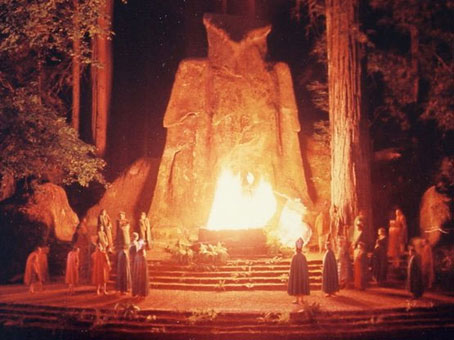 During the Creation week, there were three days of forming new “empty spaces” by dividing the original watery deep (the Abyss), then three days of filling them. A ‘world model’ develops with God’s throne at the top and the Abyss at the bottom, the place furthest from the throne. The architecture of the Tabernacle follows this model, laid out upon the ground.
During the Creation week, there were three days of forming new “empty spaces” by dividing the original watery deep (the Abyss), then three days of filling them. A ‘world model’ develops with God’s throne at the top and the Abyss at the bottom, the place furthest from the throne. The architecture of the Tabernacle follows this model, laid out upon the ground.
When the priesthood – the Land-mediators – disobeyed God, the Abyss was dredged up to cover the Land (holy place). We see this first in the flood, and later in the invasions of Assyria, Babylon and Rome.
The Valley of Hinnom became a symbol of the ‘Abyss’ below the true mountain of God. As an evil twin of the holy place, it was an ‘Adamic’ clay pit with no glorious metal. It was also the place where Judah sacrificed their infants to false gods. It was counterfeit worship in the tabernacle of hell, and the Lord said He would fill it with their bodies. Their dark ‘table of showbread’ became a snare. [Read Jeremiah 19]
After the Babylonian captivity, Zechariah saw the church in “the deep” (often translated valley or glen). A new Land-altar was rising out of the ‘waters’ – a new mountain of God, with a new Eden-temple to mediate for the world.
TAOTA
Comments Off | tags: Altar of the Abyss, Babylon, Creation Week, Exile, Gehenna, Jeremiah, Priesthood, Tabernacle, Table of Showbread, The flood, Zechariah | posted in Biblical Theology, The Restoration Era
Apr
8
2009
or Understanding the Restoration Era
Peter Leithart writes:
NT Wright has long argued that first-century Jews considered themselves to be in a continuing exile. The canon of the Hebrew Bible suggests as much.
If we take our arrangement (the LXX arrangement), the Hebrew Bible ends with Malachi, who certainly doesn’t see a gloriously restored Israel when he looks around him.
If we take the MT arrangement, the Hebrew Bible ends with the decree of Cyrus; it’s as if the return has never happened.
Either way, the canonical arrangement supports Wright’s contention.1
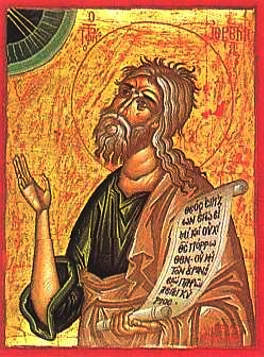 I had a long debate with my friend Matt who holds Wright’s view. I see the point. But regardless of the arrangement of the canon, what does the Bible teach?
I had a long debate with my friend Matt who holds Wright’s view. I see the point. But regardless of the arrangement of the canon, what does the Bible teach?
I subscribe to Jordan’s view that the exile/restoration prophecies actually concern the exile/restoration. When Jeremiah predicted a New Covenant with Israel and Judah, it was the one ratified at the beginning of Zechariah. It came to pass, no bull. Those who apply the prophecies of restoration directly to the first century get it wrong.2
The Jews may have thought they were still in captivity. But they also thought the second Temple was less glorious than Solomon’s. Ezekiel’s Temple was a vision of an empire-wide temple made of people, synagogues spread throughout the empire. It was a picture of a restored Israel’s greater spiritual influence, in the same way that Revelation’s new Jerusalem is a picture of the church.
Like many Christians today, they were impatient for the Messiah to come and “wash behind their ears”, fix all their problems, when He had commanded them to conquer the world with their witness. The exile was long over, and atoned for as well. The Jews failed to understand the times they lived in, and so do we in many cases. Like Israel in Ezekiel 37, the first century church was an Israel resurrected for warfare.
_______
1 Peter J. Leithart, Continuing Exile and Canon.
2 Doug Wilson’s excellent new commentary on Hebrews, Christ and His Rivals, still does this from what I have read so far. To be sure, the apostles quoted the prophets because they prefigured the first century, but the details of the prophecies anchor them in previous history.
Comments Off | tags: Doug Wilson, Exile, Ezekiel's Temple, James Jordan, Jeremiah, N. T. Wright, Peter Leithart, Revelation | posted in The Restoration Era
“Assyria dominated the ancient world in the centuries before the exile of Judah. Sometime during the reign of Jeroboam II of Israel (832–792 bc), and probably toward the latter part of that reign, the Israelite prophet Jonah had been used by God to convert the city Nineveh and all its citizens to the worship of the true God. Jonah 3:5 and 4:11 indicate that God showed His mercy to the children of the city, so that we are entitled to assume that there were God-fearing people alive for the next seventy or so years in Assyria…


